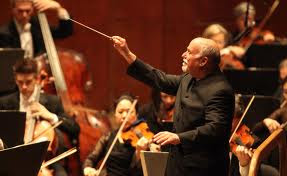David Zinman winds up The Modern Beethoven.
by Paul Pelkonen
by Paul Pelkonen
 |
| David Zinman demonstrates baton technique. Photo by Chris Lee. © 2012 The New York Philharmonic. |
This is the last week of The Modern Beethoven, the New York Philharmonic's spring festival pairing six of the composer's symphonies with unfamiliar concertos from the 20th century. This festival is the brain-child of David Zinman, the Bronx-born conductor whose uncompromising approach to music-making strips years of aural varnish from Beethoven's familiar scores.
The concert opened with a boisterous, no-frills reading of Beethoven's First Symphony. Mr. Zinman created a fresh musical statement from this early example of the composer's style, choosing energetic, but not hurried tempos. The orchestra responded, playing with great clarity and refinement.
The "modern" work on the program was the most interesting yet: the first Philharmonic performances of Karl Amadeus Hartmann's 1939 Concerto funèbre for violin and orchestra with soloist Gil Shaham. Despite a few Webern-esque squawks in the opening bars, this 20-minute concerto, played in one continuous movement, proved appealing, and yes, tonal.
A German composer who was profoundly unsympathetic to the Nazis, Hartmann wrote this piece as the storm clouds of World War Two gathered. Musically, this concerto forms a bridge between the diaphanous fabrics of Wagner's Parsifal (which it quotes, repeatedly) and the war symphonies of Shostakovich. Hartmann also incorporates Czech and Russian folk songs, expressing sympathy those countries, soon to be attacked by the Nazi war machine.
Mr. Shaham played with a keening, dry tone from the opening, a chorale based on a Hussite hymn from what is now the Czech Republic. The soloist was all business, making his instrument sob with grief in the slow section of the work, scratching out minor chords of rage like a speed-metal riffer in the Allegro. The finale featured a second chorale, evoking the fate of Russia as it stood in the path of the Nazi war machine. It came to a quiet close, then regenerated for a powerful coda, ending with loud, brash chords.
Mr. Shaham played with a keening, dry tone from the opening, a chorale based on a Hussite hymn from what is now the Czech Republic. The soloist was all business, making his instrument sob with grief in the slow section of the work, scratching out minor chords of rage like a speed-metal riffer in the Allegro. The finale featured a second chorale, evoking the fate of Russia as it stood in the path of the Nazi war machine. It came to a quiet close, then regenerated for a powerful coda, ending with loud, brash chords.
The concert ended with a Beethoven heavyweight: the 50-minute Eroica Symphony. Mr. Zinman's approach to this familiar score is to bring out details in the music that may have gone unheard before. The first movement had great detail, especially a theme in the low strings that later becomes the basis of the finale. The funeral march was philosophical, but not dragging in tone.
The infusion of energy common to this conductor's podium style occurred in the third movement, a boisterous scherzo that allowed the Philharmonic's woodwinds and brass their turn in the spotlight.Although the horns, led by principal Philip Myers did not sound their best here, the playing had a rude energy that made up for dodgy intonation.
Best of all was the finale, that famous theme and variations where the composer treats the sections and sub-sections of the ensemble as players in an oversized piece of chamber music. As the theme was tossed between the player, Mr. Zinman occasionally beckoned for more volume, or made an hermetic slashing pattern with his baton. The result: an invigorating performance of this famous symphony, and a fitting close to three weeks of The Modern Beethoven.




